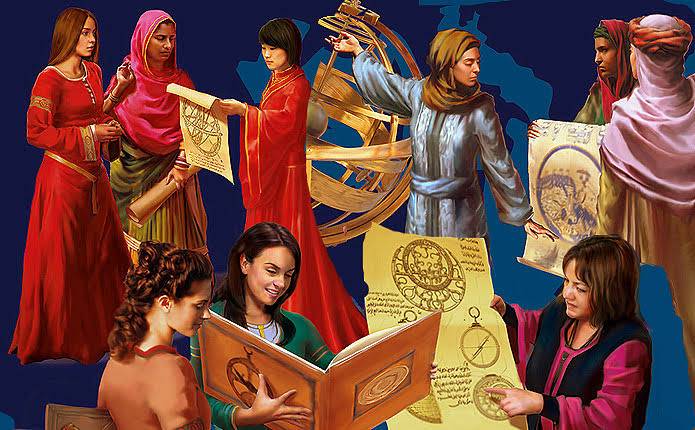
Islamic history is full of famous women scholars, scientists, and teachers who defying the odds shaped their intellectual worlds. In a twitter thread, Ali A Oolmi sheds light on scientific and religious contributions by Muslim women in pre-modern times.
Sutayta al Mahmali was one of the great mathematical minds of 10th century Baghdad. She was learned in the algebraic tradition of Al Khwarizmi. She was regularly consulted for problems of inheritance and biographers note she came up with her own original solutions. Al Baghdadi also notes she was also versed in Islamic sciences and issued fatwas.
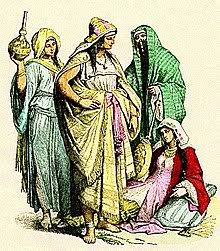
Al-ʻIjliyyah bint al-ʻIjliyy al Astrulabiyya popularly known as Mariam al Astrulabiyya was a famed astrolabe-maker in Aleppo and at the court of Sayf al Dawlah in the 10th century. Learning her craft from her father, she made astrolabes, a complicated astronomical instrument. Making an astrolabe required a working knowledge of astronomy, practical mathematics, and precise craftsmanship.
Fatimah al Majritiya was another expert astronomer and astrolabe-maker from Cordoba. Astrolabes were also used by women like the 9th century Queen Bawran the famed astrologer queen who used her knowledge to predict danger to Caliph Al Mu'tasim and prevented his death. Her use of the astrolabe indicates an advanced knowledge of mathematics and astronomy along with versatility in reading the various planetary tables.
The 11th century astronomer Al Biruni would dedicate his astrological treatise, Kitab al-tafhim li-awa’il sina‘at al-tanjim to Princess Rayhana. Often overlooked is the didactic structure of the work which indicate the text was likely a collaboration between Rayhana & Al Biruni. If so, Rayhana would have been one of the most learned women of her age.
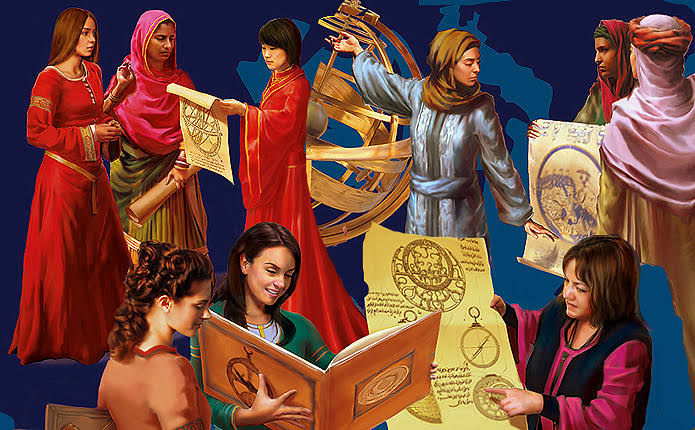
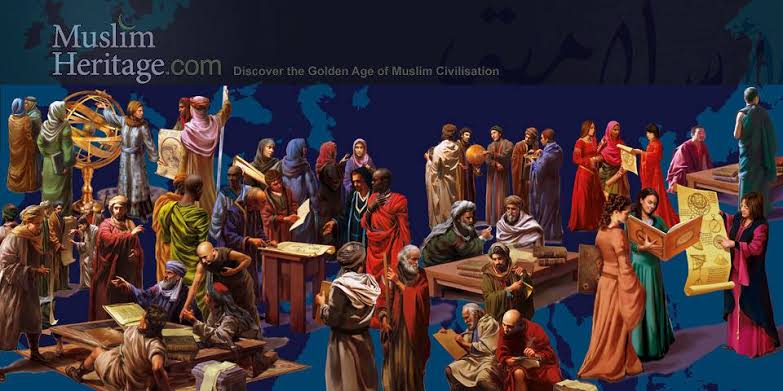
Lubna served the Ummayd court in Cordoba in the 10th century. As chief librarian and book-keeper she acquired a vast collection for the court of 500,000 books. In addition to her collection and preservation of knowledge she was a renowned mathematician and poet.
There were also women in medicine.
Rufaida Al-Aslamia of the 7th century is accredited with being the first Muslim nurse and field surgeon. Setting up her tent alongside the battlefield she treated the Muslim wounded and would go on to train others in healing and medicine. The 7th century Zaynab al-Awadiya was a healer who specialized in treating eye wounds, sores, and injuries.
And of course, the contributions of women to the Islamic sciences and religion are countless.
The very body of prophetic tradition and the sayings of Muhammad owe immensely to his wives, especially Aisha and Hafsa bin Umar both of whom became transmitters of his sayings and teachers after his death. The early development of Islam relies heavily in part on the instruction, attestations, and transmissions of Aisha and Hafsa to such a degree that some historians argue the development of the body of traditions called the sunnah is indebted to both of them.
Of the next generation there was Umm al Darda as Sughra who a jurist and scholar in Damascus and Jerusalem. So great was her learning and expertise, the Umayyad caliph Abd al Malik ibn Marwan was said to have studied with her.
Zaynab bint Ali was of legendary piety and learning. Some accounts indicate she tended the wounded and nursed the injured during the Battle of Karbala. In the presence of Yazid, she would give a defiant sermon castigating him for his tyranny and violence.
Her stand against her family’s killer and her erudite sermon would become an inspiration for generations.
Fatima al Batayahiyyah was a hadith scholar of the 8th century in Damascus. A legendary lecturer and teacher she took on many students. In her old age she moved to Medina where she taught from the prophet’s mosque.
Among these great teachers were famed mystics like Rabia al-Adawiyya 8th century.
Motivated by an unconditional love of God and deep asceticism, she became a legendary Sufi and poet. In one legendary account she is seen rushing across the city with two bowls, one with fire and the other with water. When inquired what she was doing, she claimed she wanted to set fire to heaven and put out the fire of hell for they interfered with the true love of God.
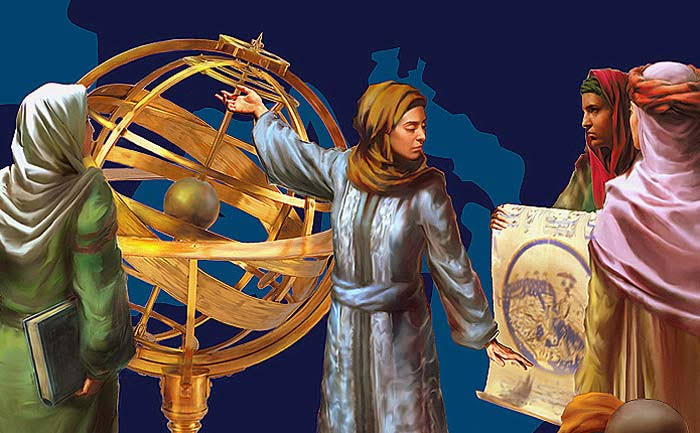
Following her, Sayyida Nafisa was an ascetic in 8th and 9th century Egypt. Renowned for her piety there are several miracles attributed to her like the curing of a blind child. Another time she is said to have prayed for the rising of the Nile and God granted her prayer. She earned a reputation as a great teacher and the jurist Imam Shafi’i was said to be a frequent guest and student of hers. According to Kecia Ali: Nafisa, as the designation “Sayyida” proclaims, is a descendant of the Prophet; she's also the daughter-in-law of Ja'far al-Sadiq. Her standard bio outlines emerged more than a century after her death in 824 & was embellished greatly as veneration of her grew in the 12th century.
The 11th century Shuhdah al-Baghdadiyyah was another famous scholar of hadith and whose learning was so legendary her classes were always packed. Fatima al Samarqandi was a 12th century jurist and scholar. Though married to another jurist, she would become as famous if not more than her husband. Educated in the Hanafi school, she would become the tutor, adviser, and counselor of Nur ad-Din Zengi, the mentor of Saladin.
Aishah al-Bauniyyah was a Sufi of the 16th century who taught the principles of Sufism and religious sciences. She issued legal fatwas and lectured in the religious sciences. She was a prolific writer and teacher who memorized the entirety of the Qur’an. The 17th Century Princess Gulbadan Begum was a famous chronicler who wrote the Humayun-nama on the Mughal dynasty.
Truly epic, she recounts the clash between Mughal brothers, fratricide, and the grief of the family.
Finally in the 19th century, the daughter of the founder of the Sokoto caliphate, Nana Asma’u, was a Fula princess and scholar.
She was responsible for the religious education of women by creating a sisterhood of expert women teachers.
While many of these women are attested to in biographies their accomplishments are usually attached to or connected to men; a problem enduring even in contemporary scholarship where women scholars are rarely cited as noted by Kecia Ali. The struggle against patriarchal societies was an ongoing one but the modern era with its Puritan reforms coupled with colonial exploitation introduced unique problems including the silencing of the past. (See Asma Sayeed’s 'Women and the Transmission of Religious Knowledge in Islam')
It would be the 19th century Lebanese writer, Zaynab Fawwaz, and her magisterial biographical dictionary which would collect the most significant details about the lives of Muslim women scholars in the premodern world. Yet, even the term “scholar” can be tricky here. Some are inclined to restrict the definition to only those in the realm of jurisprudence. Are transmitters of hadith like Aisha scholars then? Are teachers also scholars? The restricted definition of scholar can be problematic particularly as we think about the role of women in early Islam.
Indeed what is Islam or its development without Aisha or Zaynab? Where does that place astrolabe-makers or mathematicians? Despite these questions, there is no doubt women in the Islamic world achieved great learning and in turn taught others. They defied societal restrictions and even today defy our definitions of who is and who is not a scholar.
